Customize Your Plots
Last time
ggplotis built on LAYERS- Layer 1:
ggplot(data = , aes(x = , y = )) + - Layer 2:
geom_something(size = , aes(color = )) - Layer 3:
labs(x = "x-axis label", y = "y-axis lable")
- Layer 1:
geom_controls the shape of the data pointsgeom_densityfor density plotsgeom_pointfor scatter plotsgeom_barfor bar plots, etc...
Aesthetics control something in that particular layer
- If it comes from the data, wrap it inside
aes() - If not, no need for the
aes() - Aesthetics we looked at:
size,color,fill,alpha
- If it comes from the data, wrap it inside
Today
Customizing our plots
- Color palettes
- Themes
- Manually changing things in your plot
Color Palettes
These can be very useful:
- You have a TON of data and want to maximize the differences between colors
- You want your colors to scale from dark to light (or vice versa)
- You want to use colors that are colorblind friendly
- You're bored of the default
ggplot2colors
Color Palettes
These can be very useful:
- You have a TON of data and want to maximize the differences between colors
- You want your colors to scale from dark to light (or vice versa)
- You want to use colors that are colorblind friendly
- You're bored of the default
ggplot2colors
The most popular collection of palettes comes from a package called RColorBrewer. If you don't already have this installed, please do so now.
RColorBrewer Palettes
All of the color palettes available through RColorBrewer (and to view this yourself):
library(RColorBrewer)display.brewer.all()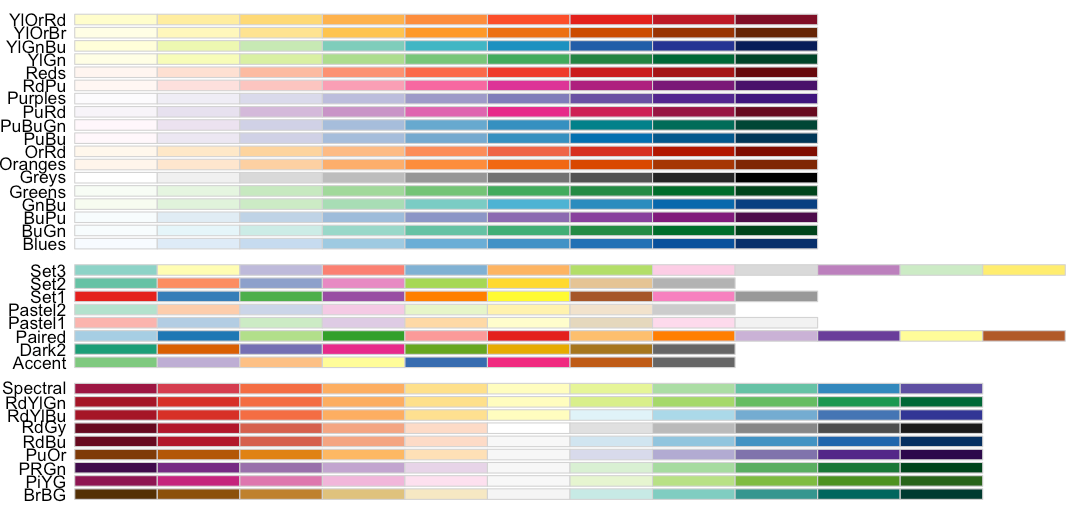
RColorBrewer Palettes
You don't have to stare at all of these. See if they fit your specifications. For example:
# find palettes with 10 colors that are color blind friendlydisplay.brewer.all(n = 10, colorblindFriendly = TRUE)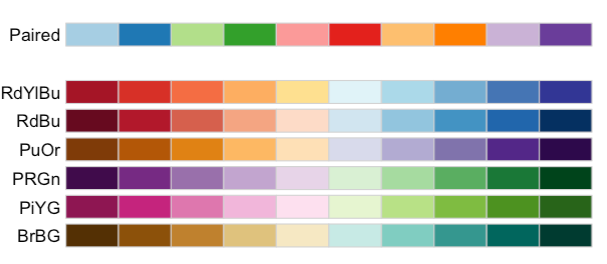
RColorBrewer Palettes
Once you know the name of the palette you want to use, you add a LAYER with the info
ggplot(data = empire, aes(x = name, y = mass)) + geom_col(aes(fill = name)) + scale_fill_brewer(palette = "PRGn")
RColorBrewer Palettes
- The format is
scale_SOMETHING_brewer SOMETHINGneeds to match the aesthetic- We used
fill, so it'sscale_fill_brewer - If you used
color, it would bescale_color_brewer
Want more color palettes?
There are seriously TONS of color palettes available to you. Some are great, and some are kind of ridiculous. Examples:
- Wes Anderson themed palettes (check it out here)
- The package
ggscicontains color palettes for scientific journals & sci-fi TV shows. See here. - For a complete list, check out this Github repo.

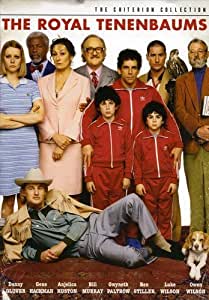

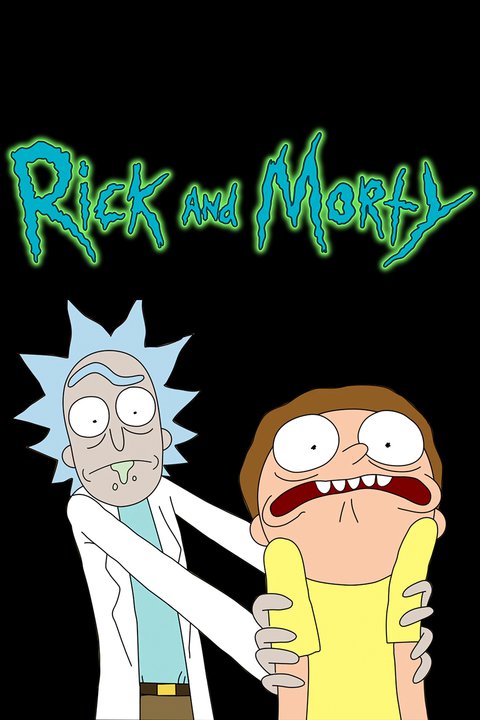
Non-RColorBrewer palettes
No matter what, you'll need to install the packages that contain the palettes
# This package includes color palettes# for scientific journals & sci fi shows!install.packages("ggsci")library(ggsci)ggplot(data = empire, aes(x = name, y = mass)) + geom_col(aes(fill = name)) + scale_fill_futurama() + labs(title = "Good News, Everyone!")Always check the help documentation if you don't know how to use it!

Themes
Themes change the entire look of your plot. Most of the themes you need are built into the main ggplot2 package.
If you want more themes, check out:
- the
ggthemespackage - the
ggthemerpackage - My fav: to make plots in the style of XKCD comics, see here
We will stick to the basic themes just so you can get a sense of things.
Side Note
Before we get going, let's create the same age_category variable that we made in the 09: Stats & Plot Practice
midus$age_category <- cut(x = midus$age, breaks = c(28, 40, 60, 84), labels=c("young", "middle", "old"), include.lowest = TRUE)Themes
No specified theme
The default for ggplot2 plots
ggplot(data = midus, aes(x = heart_father, y = life_satisfaction)) + geom_violin(aes(fill = heart_father)) + labs(x = "Dad Heart Attack?", y = "Life Satisfaction", title = "No Set Theme")
Themes
Black & White theme
ggplot(data = midus, aes(x = heart_father, y = life_satisfaction)) + geom_violin(aes(fill = heart_father)) + labs(x = "Dad Heart Attack?", y = "Life Satisfaction", title = "Black & White Theme") + theme_bw()
Themes
Black & White theme
You can still modify the theme. For example, let's change the baseline font size to be much smaller
ggplot(data = midus, aes(x = heart_father, y = life_satisfaction)) + geom_violin(aes(fill = heart_father)) + labs(x = "Dad Heart Attack?", y = "Life Satisfaction", title = "Black & White Theme") + theme_bw(base_size = 7)
Themes
Classic theme
ggplot(data = midus, aes(x = heart_father, y = life_satisfaction)) + geom_violin(aes(fill = heart_father)) + labs(x = "Dad Heart Attack?", y = "Life Satisfaction", title = "Classic Theme") + theme_classic()
Themes
Dark theme
ggplot(data = midus, aes(x = heart_father, y = life_satisfaction)) + geom_violin(aes(fill = heart_father)) + labs(x = "Dad Heart Attack?", y = "Life Satisfaction", title = "Dark Theme") + theme_dark()
Themes
Void theme
ggplot(data = midus, aes(x = heart_father, y = life_satisfaction)) + geom_violin(aes(fill = heart_father)) + labs(x = "Dad Heart Attack?", y = "Life Satisfaction", title = "Void Theme") + theme_void()
The Nitty Gritty of Themes
What if you like a theme, but you still want to make changes? For example, you like the black & white theme, but you still want to:
- get rid of major grid lines
- remove the title from your legend
- center the title
- make a black box around your legend, and fill it with the color gray
The Nitty Gritty of Themes
What if you like a theme, but you still want to make changes? For example, you like the black & white theme, but you still want to:
- get rid of major grid lines
- remove the title from your legend
- center the title
- make a black box around your legend, and fill it with the color gray
To do this, you first define your theme, then add another theme() layer that includes arguments with your specific changes. You pick an argument you want to change, set it equal to one of the following 4 options, and finally put your changes inside one of these 4 options. You can think of these as "wrappers":
element_textelement_rectelement_lineelement_blank
This gives us an overwhelming amount of flexibility. GOOGLE IS YOUR FRIEND!
Nitty Gritty of Themes
# without changesggplot(data = midus, aes(x = heart_father, y = life_satisfaction)) + geom_violin(aes(fill = heart_father)) + labs(x = "Dad Heart Attack", y = "Life Satisfaction", title = "Black and White Theme") + theme_bw()
# WITH changesggplot(data = midus, aes(x = heart_father, y = life_satisfaction)) + geom_violin(aes(fill = heart_father)) + labs(x = "Dad Heart Attack", y = "Life Satisfaction", title = "Black and White Theme") + theme_bw() + theme(panel.grid.major = element_line(color = NA), legend.title = element_blank(), plot.title = element_text(hjust = 0.5), legend.background = element_rect(color = "black", fill = "gray"))
Manually Changing Things
As you can tell, there are many ways to change aspects of ggplot2 plots. Next up is a selection of changes that are fairly common. To find the exact values for something, use Google!
- "change shapes in ggplot2" -- good search
- "shapes plot R" -- bad search
The random assortment:
- Manually set the shape of points in a scatterplot
- Manually set the color/fill
- Grayscale
- Changing the location, title, and labels of the Legend
- Change scale of plot axes
- Change angle of text labels
Manually setting shapes, colors, and fills
- Shapes take on certain numbers
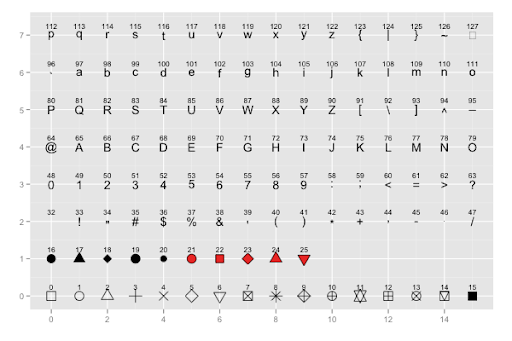
- Colors & fills
- Can take a name like
"cornflowerblue"(see here for more preset colors) - Can take a hex code
- 6 digit alphanumeric
- always leads with a
# - Hex code of cornflowerblue = #6495ed
- Can take a name like
Manually setting shapes, colors, and fills
ggplot(data = midus, aes(x = self_esteem, y = life_satisfaction)) + geom_point(aes(color = age_category, shape = age_category)) + labs(x = "Self-Esteem", y = "Life Satisfaction", title = "Manually Setting Shapes") + scale_shape_manual(values = c(9,10,11))The variable "age_category" has 3 levels: young, middle, old. So if you want to manually set the shapes for the 3 levels, you need to supply 3 values!

Manually setting shapes, colors, and fills
ggplot(data = midus, aes(x = self_esteem, y = life_satisfaction)) + geom_point(aes(color = age_category, shape = age_category)) + labs(x = "Self-Esteem", y = "Life Satisfaction", title = "Manually Setting Shapes") + scale_shape_manual(values = c(9,10,11)) + scale_color_manual(values = c("seagreen4", "darkorchid", "#FF6700"))Same thing for colors!

Grayscale
Many academic journals charge more money for color printing (which is dumb), so you might want everything to be on some form of grayscale. 0 = black, 1 = white.
ggplot(data = midus, aes(x = self_esteem, y = life_satisfaction)) + geom_boxplot(aes(fill = age_category)) + labs(x = "Self-Esteem", y = "Life Satisfaction", title = "All Grey") + theme_classic() + scale_fill_grey(start = 0, end = 0.8, labels = c("young", "middle", "old"))
Changing the legend
The title of your legend will be the name of your variable. If you have something like age_category, that doesn't look as nice as a formatted title. You can change the variable name within your dataset. But that can often have unintended consequences.
If all you're doing is changing the title of the legend, this is probably the simplest method:
ggplot(data = midus, aes(x = self_esteem, y = life_satisfaction)) + geom_point(aes(color = age_category, shape = age_category), alpha = .5) + labs(x = "Self-Esteem", y = "Life Satisfaction", title = "Legend Change", color = "Age (by group)", shape = "Age (by group)")
Changing the legend
If you want to change other aspects of the legend, like the location and the labels...
ggplot(data = midus, aes(x = self_esteem, y = life_satisfaction)) + geom_point(aes(color = age_category, shape = age_category), alpha = .5) + labs(x = "Self-Esteem", y = "Life Satisfaction", title = "Legend Change Part 2") + scale_color_discrete(name = "Age (by group)", labels = c("YOUNG", "MID", "OLD")) + theme(legend.position = "bottom")
Changing the legend
To get rid of a legend (which you often will do if you have 2 aesthetics mapped), set the appropriate guide = FALSE
ggplot(data = midus, aes(x = self_esteem, y = life_satisfaction)) + geom_point(aes(color = age_category, shape = age_category), alpha = .5) + labs(x = "Self-Esteem", y = "Life Satisfaction", title = "Legend Change Part 2") + scale_color_discrete(name = "Age (by group)", labels = c("YOUNG", "MID", "OLD")) + theme(legend.position = "bottom") + scale_shape(guide = FALSE)
Changing the legend
Both legends gone...
ggplot(data = midus, aes(x = self_esteem, y = life_satisfaction)) + geom_point(aes(color = age_category, shape = age_category), alpha = .5) + labs(x = "Self-Esteem", y = "Life Satisfaction", title = "Legend Change Part 2") + scale_color_discrete(guide = FALSE) + scale_shape(guide = FALSE)
Changing the scales of axes
You might want to adjust the scale of your axes to best reflect your data
ggplot(data = midus, aes(x = self_esteem)) + geom_density(aes(fill = heart_self), alpha = .5) + labs(x = "Self-Esteem", y = "Density", title = "Coord Change", subtitle = "Default") + theme_classic()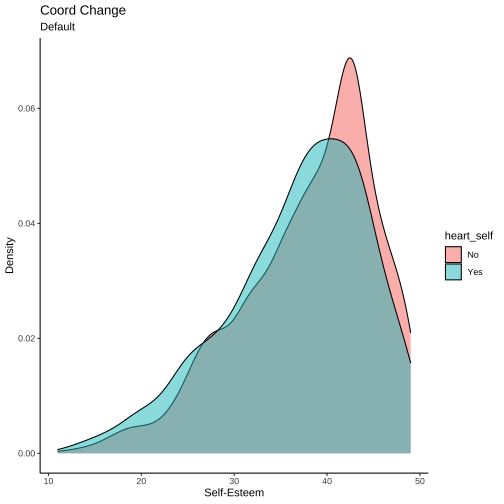
ggplot(data = midus, aes(x = self_esteem)) + geom_density(aes(fill = heart_self), alpha = .5) + labs(x = "Self-Esteem", y = "Density", title = "Coord Change", subtitle = "Adjusted Coordinates") + theme_classic() + xlim(c(0, 80))
Axis labels
Sometimes, you can get really cramped axis labels. There are different ways to deal with this.
2 key things to know is that you can adjust vertically and horizontally:
hjust= horizontal justification. 0 = left-justified, 1 = right-justified, .5 = center-justifiedvjust= vertical justification. 0 = bottom, 1 = top, .5 = center
BUT, if you change the angle on something, the horizontal/vertical thing gets really confusing. Just try both until you get what you want.
(Note: going to switch back to the empire data.frame for a better example)
Axis labels
Let's change only the angle of the labels...
ggplot(data = empire, aes(x = name, y = mass)) + geom_col(aes(fill = name)) + scale_fill_futurama(guide = FALSE) + labs(title = "Good News, Everyone!", subtitle = "Angle Only") + theme(axis.text.x = element_text(angle = 90))
Axis labels
If you stare closely, you'll notice that the names don't line up with the tic marks! Even though this would normally be a horizontal alignment, you changed the angle of the text to 90...so we use the vertical alignment instead!
ggplot(data = empire, aes(x = name, y = mass)) + geom_col(aes(fill = name)) + scale_fill_futurama(guide = FALSE) + labs(title = "Good News, Everyone!", subtitle = "Angle & Alignment") + theme(axis.text.x = element_text(angle = 90, vjust = .5))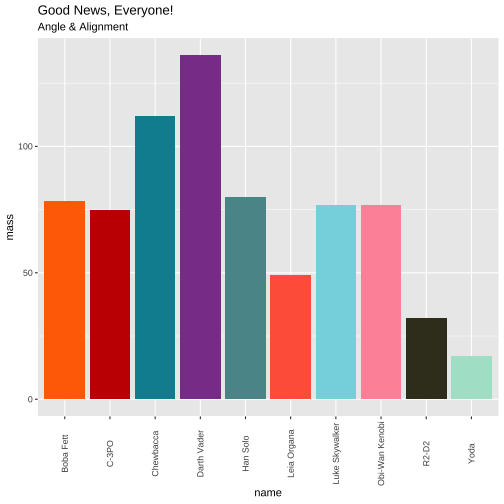
Axis labels
What if we want the last letter of every label to be right up against the tic mark? Normally, this would be vertical alignment. But since we're flipped, it's not horizontal alignment.
ggplot(data = empire, aes(x = name, y = mass)) + geom_col(aes(fill = name)) + scale_fill_futurama(guide = FALSE) + labs(title = "Good News, Everyone!", subtitle = "Angle & Alignment") + theme(axis.text.x = element_text(angle = 90, vjust = .5, hjust = 1))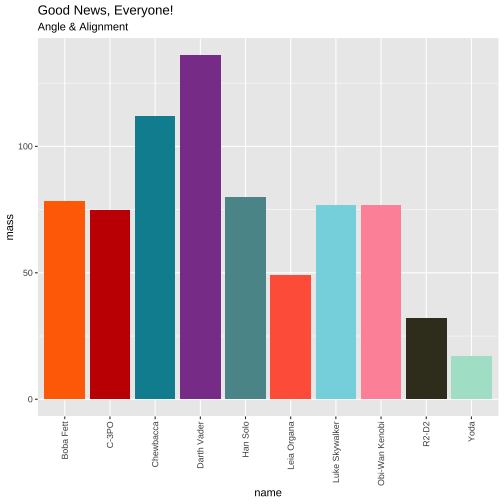
Axis labels
How about other angles? You just need to play around until you find one you like!
ggplot(data = empire, aes(x = name, y = mass)) + geom_col(aes(fill = name)) + scale_fill_futurama(guide = FALSE) + labs(title = "Good News, Everyone!", subtitle = "Angle & Alignment") + theme(axis.text.x = element_text(angle = 45, vjust = 1, hjust = 1))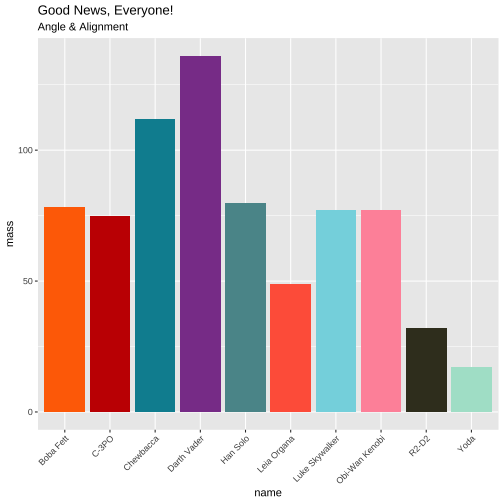
Axis labels
As of the most recent version of ggplot2 (v.3.3.0), you can now stagger the axis labels so they don't overlap!
Without adjusting anything, notice how some of the labels overlap
ggplot(data = empire, aes(x = name, y = mass)) + geom_col(aes(fill = name)) + scale_fill_futurama(guide = FALSE) + labs(title = "Good News, Everyone!", subtitle = "Overlapping Labels")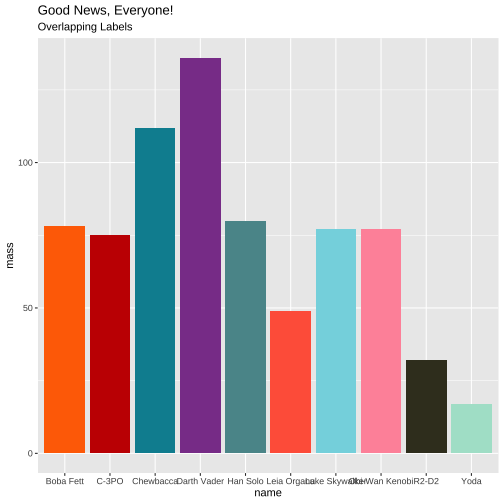
Axis labels
As of the most recent version of ggplot2 (v.3.3.0), you can now stagger the axis labels so they don't overlap!
With adjustment, we can fix that by "dodging" the labels!
ggplot(data = empire, aes(x = name, y = mass)) + geom_col(aes(fill = name)) + scale_fill_futurama(guide = FALSE) + labs(title = "Good News, Everyone!", subtitle = "Overlapping Labels") + scale_x_discrete(guide = guide_axis(n.dodge = 2))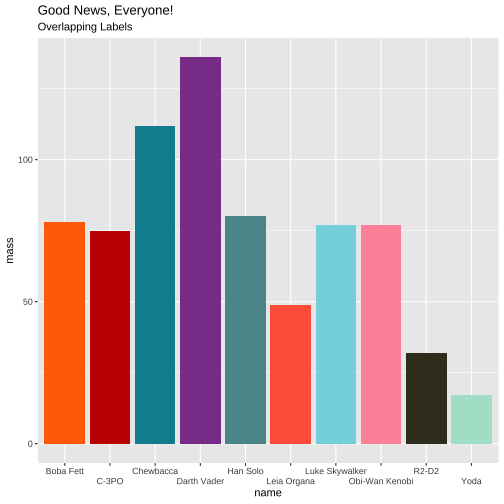
Next up...
- Multipanel Figures
- Adding things like best fit lines, text etc.